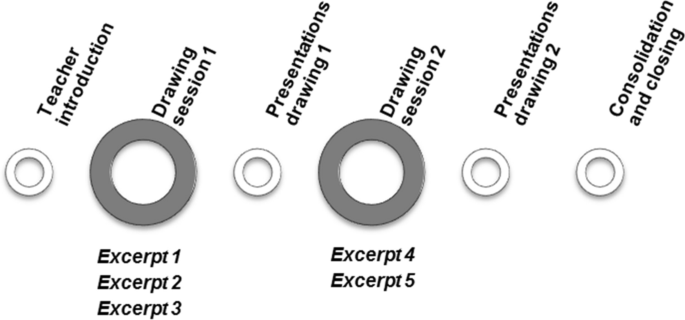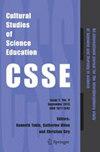The role of teacher support in students’ engagement with representational construction
IF 1.5
4区 教育学
Q2 CULTURAL STUDIES
引用次数: 0
Abstract
Abstract In this article, we study the role of teacher support in a collaborative learning setting that involves students’ constructions of visual representations in the environmental education context. Despite the consensus in the field of science education research that engagement with visual representations—such as diagrams, animations, and graphs—can support students’ conceptual understanding, studies reveal that learning from engagement with visual representations can be challenging for students. Adopting a sociocultural approach, this study contributes to extant research by analytically scrutinizing the role of teacher support in learning activities that revolve around students’ construction of visual representations. The empirical basis is a science project in which lower secondary school students drew and refined depictions of the effects of anthropogenic climate change. The analytical focus is on student–teacher interactions during group-based drawing activities in which students created representations of the carbon cycle and interacted with authorized representations. The analyses revealed how students found it challenging to compare, contrast, and integrate authorized representations and, additionally, to constructively use authorized representations in the process of designing their own representations. To support students in their efforts to construct scientific meaning, the teacher oriented the students’ attention towards the salient features of representations, supported students in making sense of ‘semiotic signs’, and enabled them to link scientific concepts with detailed depictions. In addition to the different forms of support provided by the teacher, the analyses of the student–teacher interactions also reveal the teacher’s use of specific ‘talk moves’ of elaboration and eliciting. The key implications include that teachers should select representations that are sufficiently different in terms of how concepts and phenomena are depicted, and that teachers should be prepared to support students in how to compare and contrast multiple representations. Further, strategies for supporting students’ exploration of their own ideas and suggestions are essential in the dynamics between students’ self-made representations and authorized representations.

教师支持在学生参与表征建构中的作用
在本文中,我们研究了教师支持在环境教育背景下涉及学生视觉表征构建的协作学习环境中的作用。尽管科学教育研究领域的共识是,参与视觉表征(如图表、动画和图形)可以支持学生的概念理解,但研究表明,从参与视觉表征中学习对学生来说可能是具有挑战性的。本研究采用社会文化的方法,通过分析审视教师支持在围绕学生构建视觉表征的学习活动中的作用,为现有的研究做出了贡献。实证基础是一个科学项目,在该项目中,低年级学生绘制并完善了人为气候变化影响的描述。分析的重点是在以小组为基础的绘画活动中,学生创造碳循环的表示,并与授权的表示进行互动。分析揭示了学生如何发现比较、对比和整合授权表示,以及在设计自己的表示过程中建设性地使用授权表示是具有挑战性的。为了支持学生努力构建科学意义,教师将学生的注意力引导到表征的显著特征上,支持学生理解“符号符号”,并使他们能够将科学概念与详细描述联系起来。除了教师提供的不同形式的支持外,对师生互动的分析还揭示了教师使用具体的阐述和引出的“谈话动作”。关键的含义包括,教师应该选择在如何描述概念和现象方面足够不同的表征,教师应该准备好支持学生如何比较和对比多种表征。此外,支持学生探索自己的想法和建议的策略在学生自制陈述和授权陈述之间的动态中是必不可少的。
本文章由计算机程序翻译,如有差异,请以英文原文为准。
求助全文
约1分钟内获得全文
求助全文
来源期刊

Cultural Studies of Science Education
Multiple-
CiteScore
3.10
自引率
0.00%
发文量
45
期刊介绍:
Cultural Studies of Science Education is a peer reviewed journal that provides an interactive platform for researchers working in the multidisciplinary fields of cultural studies and science education. By taking a cultural approach and paying attention to theories from cultural studies, this new journal reflects the current diversity in the study of science education in a variety of contexts, including schools, museums, zoos, laboratories, parks and gardens, aquariums and community development, maintenance and restoration.
This journal
focuses on science education as a cultural, cross-age, cross-class, and cross-disciplinary phenomenon;
publishes articles that have an explicit and appropriate connection with and immersion in cultural studies;
seeks articles that have theory development as an integral aspect of the data presentation;
establishes bridges between science education and social studies of science, public understanding of science, science/technology and human values, and science and literacy;
builds new communities at the interface of currently distinct discourses;
aims to be a catalyst that forges new genres of and for scholarly dissemination;
provides an interactive dialogue that includes the editors, members of the review board, and selected international scholars;
publishes manuscripts that encompass all forms of scholarly activity;
includes research articles, essays, OP-ED, critical, comments, criticisms and letters on emerging issues of significance.
 求助内容:
求助内容: 应助结果提醒方式:
应助结果提醒方式:


